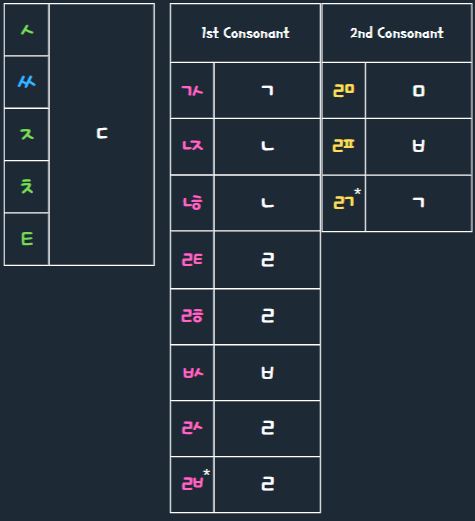Batchim in Korean
The Korean text pronunciation feature (🔊) is only available for Chrome, Edge, Safari, and Opera browsers.
Definition
In the Korean language, a batchim (받침) is a consonant that is placed at the bottom of a syllable block. It is the final consonant in a syllable and is written after the vowel in the syllable block.
We can distinguish three types of batchims based on the number and type of consonants in a syllable.
홑받침 (hot batchim)
One consonant ㄱ, ㄴ, ㄷ, ㄹ, ㅁ, ㅂ, ㅅ, ㅇ, ㅈ, ㅊ, ㅋ, ㅌ, ㅍ, ㅎ

쌍받침 (ssang batchim)
Two same consonants ㄲ, ㅆ

겹받침 (kyeop batchim)
Two different consonants ㄳ, ㄵ, ㄶ, ㄾ, ㅀ, ㅄ, ㄽ, ㄻ, ㄿ, ㄺ, ㄼ

How to read batchim?
ㅅ, ㅆ, ㅈ, ㅊ, ㅌ
ㅅ, ㅆ, ㅈ, ㅊ, ㅌ must be pronounced as ㄷ [ t ] if followed by a consonant or nothing (exception: consonants ㄴ and ㅁ).
ㅅ
빗다
[ 빋따 ]
ㅆ
있다
[ 읻따 ]
ㅈ
낮
[ 낟 ]
ㅊ
꽃
[ 꼳 ]
ㅌ
맡기다
[ 맏끼다 ]
Please note that if ㅅ, ㅆ, ㅈ, ㅊ, ㅌ are followed by ㄴ or ㅁ, then ㅅ, ㅆ, ㅈ, ㅊ, ㅌ must be pronounced as ㄴ [ n ]. Read more about pronunciation rules for letter ㄷ here.
If ㅅ, ㅈ, ㅊ, ㅌ, ㅆ are followed by a vowel, they must be pronounced according to their original sound.
ㅅ
빗어요
[ 비서요 ]
ㅆ
있어요
[ 이서요 ]
ㅈ
낮에
[ 나제 ]
ㅊ
꽃이
[ 꼬치 ]
ㅌ
맡은
[ 마튼 ]
ㄳ, ㄵ, ㄶ, ㄾ, ㅀ, ㅄ, ㄽ, ㄼ, ㄻ, ㄿ, ㄺ
If kyeop batchim is followed by a consonant* (see exceptions) or nothing, then only one consonant must be pronounced.
First consonant
ㄳ
몫
[ 목 ]
ㄵ
앉다
[ 안따 ]
ㄶ
않다
[ 안타 ]
ㄾ
핥다
[ 할따 ]
ㅀ
싫다
[ 실타 ]
ㅄ
값
[ 갑 ]
ㄽ
외곬
[ 외골 ]
ㄼ
여덟
[ 여덜 ] *
* Exception: 밟다 [ 밥따 ]
Second consonant
ㄻ
삶
[ 삼 ]
ㄿ
읊다
[ 읍따 ]
ㄺ
읽다
[ 익따 ]*
*
읽기
[ 일끼 ]
Exceptions
If ㄵ, ㄺ, or ㄼ is followed by ㅎ, ㅈ, ㄱ, or ㅂ, like this [ ㄵ + ㅎ or ㅈ ], [ ㄼ + ㅎ or ㅂ ], [ ㄺ + ㅎ or ㄱ ], then all letters must be pronounced.
At the same time, if [ ㄵ → ㅎ ], [ㄼ → ㅎ], [ ㄺ → ㅎ ] then ㅈ, ㄱ, ㅂ must be pronounced as ㅊ, ㅋ, ㅍ.
ㄵ
앉히다
[ 안치다 ]
ㄼ
밟히다
[ 발피다 ]
ㄺ
읽히다
[ 일키다 ]
And if [ ㄵ → ㅈ ], [ㄼ → ㅂ ], [ ㄺ → ㄱ ] then ㅈ, ㄱ, ㅂ must be pronounced as ㅉ, ㅃ, ㄲ.
ㄵ
앉지요
[ 안찌요 ]
ㄼ
여덟 번
[ 여덜 뻔 ]
ㄺ
읽기
[ 일끼 ]
If kyeop batchim is followed by a vowel sound then you should read all letters.
ㄵ
앉아요
[ 안자요 ]
ㄻ
삶이
[ 살미 ]
Quick reference (click to open)
Vowels: a, e, i, o, u
Consonants: b, c, d, f, g, h, j
Syllable: Bra-zil (2 syllables), Ar-gen-ti-na (4), In-di-a (3), Viet-nam (2), thin-king (2), beau-ti-ful (3), good (1)
Batchim: is a final consonant in a syllable. → Bra-zil (batchim: 'l'), Ar-gen-ti-na (batchims: 'r' and 'n'), In-di-a ('n'), Viet-nam ('t', 'm')
Romanization: is a conversion of text (not pronunciation ! ) from different writing system (Korean, Arabic, Russian, etc.) to the Roman (Latin) alphabet.
IPA: is an alphabetic system of phonetic (pronunciation) notation.
Noun: road, user, sister, table, sky
Pronoun: I, my, we, you, they, her
Verb: to go, to study, to think, to feel
Adjective: cold, kind, hungry, curious, expensive
Adverb: quickly, nicely, never, exactly, urgently
Preposition: from, to, on, in, with, till
Conjuction: and, because, if, but, while
Declarative sentence: I learn Korean.
Interrogative sentence: Do you learn Korean?
Imperative sentence: You must learn Korean!
Exclamative sentence: Wow, you learn Korean!
Verb / Adj. stem in Korean: part of a verb or adj. which is left after removing the last syllable -다 ( e.g. 가다 → 가, 예쁘다 → 예쁘, 듣다 → 듣 ).




